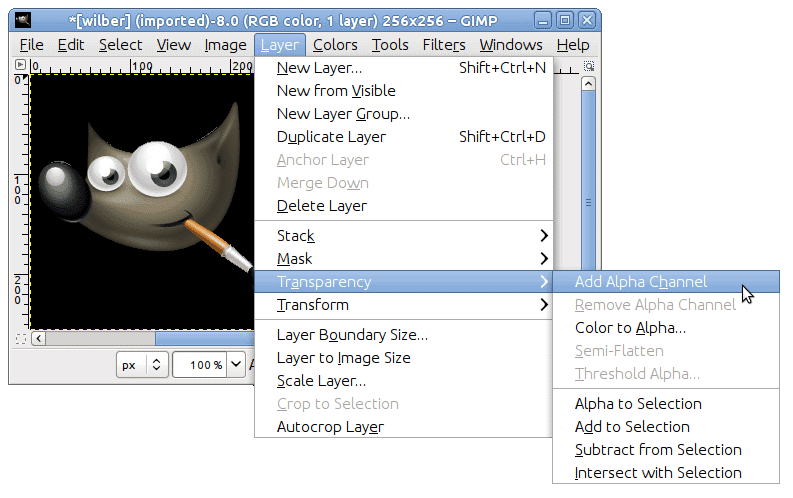The Ultimate Guide: 5 Ways to Transparent Backgrounds in GIMP

Unlocking the Power of Transparency: A Comprehensive Guide to Creating Transparent Backgrounds in GIMP

Welcome to the ultimate guide on mastering the art of transparent backgrounds using GIMP, the versatile open-source image editing software. In this comprehensive tutorial, we'll explore five effective techniques to achieve professional-grade transparent backgrounds, unlocking a world of creative possibilities for your digital projects.
Whether you're a graphic designer, a photographer, or a digital artist, the ability to isolate subjects, remove backgrounds, or create transparent overlays is a powerful skill. With GIMP's user-friendly interface and our expert guidance, you'll learn how to effortlessly achieve transparent backgrounds, elevating your visual creations to new heights.
Method 1: Using the Magic Wand Tool for Quick Selections

The Magic Wand Tool is a powerful selection tool in GIMP that simplifies the process of selecting and removing backgrounds. This method is particularly useful when working with images that have distinct color contrasts between the subject and the background.
- Open your image in GIMP and navigate to the Toolbox on the left sidebar.
- Select the Magic Wand Tool by clicking on its icon or pressing the W key.
- Click on the background area you wish to remove. The Magic Wand Tool will select similar-colored pixels based on the Tolerance setting.
- Adjust the Tolerance slider in the Tool Options panel to refine your selection. A higher tolerance selects a broader range of colors, while a lower tolerance focuses on precise color shades.
- Once your selection is complete, press Delete or use the Edit > Clear menu option to remove the selected background.
- To fine-tune your selection, use the Select > Grow or Select > Shrink options to expand or contract the selection area.
Tips for Effective Magic Wand Selections
- For images with complex backgrounds, consider using the Select by Color tool to select specific colors or shades.
- If your image has multiple distinct colors, you can use the Color to Alpha feature to convert specific colors to transparency.
- To avoid accidental selections, ensure the Contiguous option is unchecked in the Tool Options panel.
| Magic Wand Tool | Result |
|---|---|
| High Tolerance | Selects a broader range of colors |
| Low Tolerance | Precise selection of similar colors |

Method 2: Employing the Fuzzy Select Tool for Edge Detection
The Fuzzy Select Tool, also known as the Quick Mask, is an advanced selection tool that excels at detecting edges and selecting objects with intricate details.
- Open your image in GIMP and select the Fuzzy Select Tool from the Toolbox.
- Click and drag the cursor over the area you wish to select. The tool will automatically detect and select the edges of your subject.
- Adjust the Threshold slider in the Tool Options panel to fine-tune the selection. A lower threshold selects finer details, while a higher threshold selects broader areas.
- If your selection includes unwanted areas, use the Select > Feather option to soften the edges or the Select > Shrink option to reduce the selection area.
- Once your selection is refined, remove the background using the Delete key or the Edit > Clear menu option.
Advanced Fuzzy Select Techniques
- For images with fine details, increase the Threshold to capture more intricate edges.
- Combine the Fuzzy Select Tool with layer masks for precise control over your selection.
- To select multiple objects, hold Shift while clicking on each object with the Fuzzy Select Tool.
| Fuzzy Select Tool | Result |
|---|---|
| Low Threshold | Selects fine details and edges |
| High Threshold | Captures broader areas with less precision |
Method 3: Creating Transparent Backgrounds with Layer Masks
Layer masks offer unparalleled control and flexibility when creating transparent backgrounds. With layer masks, you can selectively reveal or conceal parts of an image without permanently altering the original pixels.
- Open your image in GIMP and duplicate the background layer by right-clicking on the Background layer in the Layers panel and selecting Duplicate Layer.
- Select the Background copy layer and click on the Add Layer Mask icon at the bottom of the Layers panel.
- Choose the White (full opacity) option to start with a fully visible layer mask.
- Select the Paintbrush Tool from the Toolbox and choose a soft-edged brush.
- Set the Foreground Color to Black and paint over the areas you want to make transparent.
- To refine your mask, adjust the brush size, opacity, or flow to control the transparency level.
- If you need to restore transparency, simply switch the Foreground Color to White and paint over the areas you want to reveal.
Layer Mask Best Practices
- Use a combination of black and white to control the transparency of your layer.
- For intricate details, consider using a smaller brush size and lower opacity.
- To adjust the overall transparency of your layer, adjust the Opacity slider in the Layers panel.
| Layer Mask | Result |
|---|---|
| Black Brush | Hides the layer, making it transparent |
| White Brush | Reveals the layer, restoring its visibility |
Method 4: Utilizing the Path Tool for Precise Selections

The Path Tool in GIMP is a powerful selection tool that allows you to create precise, custom selections. This method is ideal for intricate objects or subjects with complex edges.
- Open your image in GIMP and select the Path Tool from the Toolbox.
- Click and drag the cursor to create anchor points around the object you wish to select.
- Connect the anchor points by clicking and dragging between them to create a closed path.
- Once your path is complete, right-click on the path and select Path to Selection.
- The selection will now be active, allowing you to remove the background using the Delete key or the Edit > Clear menu option.
Path Tool Techniques
- For complex shapes, create multiple anchor points to capture intricate details.
- To adjust the path, select the Move Tool and drag the anchor points or use the Edit > Transform Paths menu to adjust the path's shape.
- Combine the Path Tool with layer masks for even more control over your selection.
| Path Tool | Result |
|---|---|
| Anchor Points | Define the selection's shape |
| Closed Path | Encloses the selection area |
Method 5: Applying Advanced Background Removal Techniques
For more complex images or fine details, GIMP offers advanced background removal techniques that leverage powerful algorithms and advanced tools.
- Open your image in GIMP and select the Foreground Select Tool from the Toolbox.
- Click and drag the cursor over the object you wish to select. The tool will automatically detect and select the edges.
- If the selection includes unwanted areas, use the Refine Edge option in the Tool Options panel to adjust the edge detection.
- Once your selection is refined, remove the background using the Delete key or the Edit > Clear menu option.
Advanced Background Removal Tips
- For images with hair or fine details, use the Refine Edge options to adjust the Feather and Contrast settings.
- Combine advanced selection tools with layer masks for maximum control and flexibility.
- Consider using the Smart Select Tool for images with multiple objects or complex backgrounds.
| Advanced Techniques | Result |
|---|---|
| Foreground Select Tool | Advanced edge detection for intricate subjects |
| Refine Edge | Fine-tune the selection's edge detection |
Conclusion: Mastering Transparency in GIMP
With these five comprehensive methods, you now have the tools and techniques to create transparent backgrounds in GIMP like a pro. Whether you're a seasoned designer or a novice, GIMP's versatile selection tools and layer masks empower you to unlock a world of creative possibilities.
Remember, practice makes perfect. Experiment with different techniques, refine your selections, and explore the vast potential of GIMP's features. With patience and creativity, you'll soon master the art of transparency, elevating your digital creations to new heights of visual excellence.
Can I use these techniques for other image editing software?
+Yes, the principles of transparent background creation apply across various image editing software. While the specific tools and interfaces may vary, the core concepts of selection and transparency remain consistent. You can adapt these techniques to other software like Adobe Photoshop or Affinity Photo.
How do I save my image with a transparent background in GIMP?
+To save your image with a transparent background in GIMP, ensure your desired layer is selected, then go to File > Export As. Choose a suitable file format like PNG or GIF, which support transparency. Make sure the Transparency option is checked, and then click Export to save your image.
What are some best practices for creating transparent backgrounds?
+When creating transparent backgrounds, start with a well-lit image to ensure clear edges and contrasts. Use a combination of selection tools and layer masks for precise control. Experiment with different techniques and adjust settings to achieve the desired level of transparency. Always save your work in a format that supports transparency.



